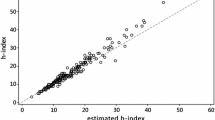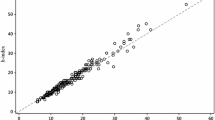Abstract
In recent issues of the ISSI Newsletter, Egghe [2006a] proposed the g-index and Kosmulski [2006] the h(2)-index, both claimed to be improvements on the original h-index proposed by Hirsch [2005]. The aim of this paper is to investigate the inter-relationships between these measures and also their time dependence using the stochastic publication/citation model proposed by Burrell [1992, 2007a]. We also make some tentative suggestions regarding the relative merits of these three proposed measures.
Similar content being viewed by others
References
Banks, M. G. (2006), An extension of the Hirsch index: Indexing scientific topics and compounds. Scientometrics, 69(1): 161–168.
Batista, P. D., Campiteli, M. G., Kinouchi, O. (2006), Is it possible to compare researchers with different scientific interests? Scientometrics, 68(1): 179–189.
Bornmann, L., Daniel, H.-D. (2005), Does the h-index for ranking of scientists really work? Scientometrics, 65(3): 391–392.
Burrell, Q. L. (1992), A simple model for linked informetric processes. Information Processing and Management, 28: 637–645.
Burrell, Q. L. (2006), Hirsch’s h-index: a preliminary stochastic model. Book of Abstracts: 9th International Science and Technology Indicators Conference, 7–9 September 2006, Leuven, Belgium, 26–28. Katholieke Universiteit, Leuven.
Burrell, Q. L. (2007a), Hirsch’s h-index: a stochastic model. Journal of Informetrics, 1(1): 16–25.
Burrell, Q. L. (2007b), On the h-index, the size of the Hirsch core and Jin’s A-index. Journal of Informetrics, 1(2): 170–177.
Burrell, Q. L. (2007c), Hirsch index or Hirsch rate? Some thoughts arising from Liang’s data. Scientometrics, 73(1): 19–28.
Burrell, Q. L. (2007d), Hirsch’s h-index and Egghe’s g-index. Paper presented at ISSI 2007 — 11 th International Conference of the International Society for Scientometrics and Informetrics. Serrano Central Campus, Spanish Research Council, Madrid, Spain, 24–28 June, 2007.
Cronin, B., Meho, L. (2006), Using the h-index to rank influential information scientists. Journal of the American Society for Information Science and Technology, 57(9): 1275–1278.
Egghe, L. (2006a), An improvement of the h-index: the g-index. ISSI Newsletter, 2(1): 8–9.
Egghe, L. (2006b), Theory and practice of the g-index. Scientometrics, 69(1): 131–152.
Egghe, L. (2006c), Dynamic h-index: the Hirsch index in function of time. Journal of the American Society for Information Science and Technology (To appear.)
Egghe, L., Rousseau, R. (2006), An informetric model for the h-index. Scientometrics, 69(1): 121–129.
Glänzel, W. (2006a), On the H-index — a mathematical approach to a new measure of publication activity and citation impact. Scientometrics, 67(2): 315–321.
Glänzel, W. (2006b), On the opportunities and limitations of the H-index. Science Focus, 1(1): 10–11. (In Chinese).
Hirsch, J. E. (2005), An index to quantify an individual’s scientific research output. Proceedings of the National Academy of Sciences of the United States of America,102(46): 16569–16572. (Also available in preprint form as arXiv:physica/0508113, accessible at http://xxx.arxiv.org/abs/physics/0508025.)
Jin, Bh. (2006), H-index: an evaluation indicator proposed by scientist. Science Focus, 1(1): 8–9. (In Chinese.)
Kosmulski, M. (2006), A new Hirsch-type index saves time and works equally well as the original h-index. ISSI Newsletter, 2(3): 4–6.
Liang, L. (2006), h-index sequence and h-index matrix: Constructions and applications. Scientometics, 69(1): 153–159.
Ross, S. (1996), Stochastic Processes. 2nd edition. New York: John Wiley.
Rousseau, R. (2006a), A case study: evolution of JASIS’ Hirsch index. Science Focus, 1(1): 16–17, (in Chinese). (English version available at E-LIS, code 5430.)
Rousseau, R. (2006b), New developments related to the Hirsch index. Science Focus, 1(4): 23–25, (in Chinese). (English version available at E-LIS, code 6736.)
Van Raan, A. J. (2006), Comparison of the Hirsch-index with standard bibliometric indicators and with peer judgment for 147 chemistry research groups. Scientometrics, 67(3): 491–502.
Author information
Authors and Affiliations
Corresponding author
Rights and permissions
About this article
Cite this article
Burrell, Q.L. On Hirsch’s h, Egghe’s g and Kosmulski’s h(2). Scientometrics 79, 79–91 (2009). https://doi.org/10.1007/s11192-009-0405-3
Received:
Published:
Issue Date:
DOI: https://doi.org/10.1007/s11192-009-0405-3




